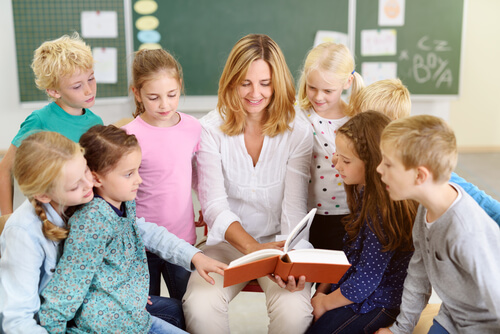5 Stories to Teach Children About Emotions

A child with good emotional health is a happy child, capable of facing complex situations. To help them develop this, you have an excellent tool: stories that teach children about emotions.
Discover how you can educate your child about emotions and feelings through storytelling.
Stories to teach children about emotions
Developing social skills is a key factor that will help children become better people.
Understanding and channeling the emotions that arise in different situations will reinforce a child’s self-confidence.
It also makes the child aware of the emotions of others and, therefore, helps them respect their feelings.
Here’s a list of some of the best stories to teach children about basic emotions.
Joy
Story: My Little Joys, written by Jo Witek and Christine Roussey
This story tells the beautiful tale of a grandmother who gives her grandson a unique box to keep treasures in.
The premise is to keep the treasures of life there: those moments that really give us joy just by remembering them.
This beautifully illustrated book will help your child understand what he values most.
In turn, you’ll also discover the things that make him happy by asking what he would keep in the box.
Empathy
Story: The Little Sheep that Came to Dinner, written by Steve Smallman and Joelle Dreidemy
This is a brief story in which feelings such as compassion and empathy are developed. It tells how a hungry wolf ends up caring for the lamb that was supposed to be his dinner.
This story awakens feelings that make children let out their compassionate and supportive side around others.
It teaches them that they can decide how to act in various circumstances that test their character and nature by exercising self-control.

Love
Story: My Love, written by Astrid Desbordes and Pauline Martin
Here our protagonist, Alchibaldo, is a boy who is about to fall asleep but asks his mother something.
This child wants to know if she’s going to love him all her life, and his mother responds with a story.
She tells him about the unconditional love a mother has for her child and how it came to exist.
This story will make your child know that, no matter what happens, you’ll love him forever. It reinforces the security of your love for him.
Stories that develop emotions involve several feelings, such as self-esteem, sincerity and kindness.
Understanding and channeling the emotions that arise in various situations will reinforce the child’s self-confidence.
Jealousy
Story: Ghosts Do Not Knock on the Door, written by Eulalia Canal Iglesias
This story tells the unusual and funny tale of two good friends, Bear and Marmota, who always play together.
The harmony of this bear is altered by the arrival of Pato, who according to Mamota puts his relationship with Bear at risk.
This story mainly addresses the feeling of friendship, but the background of the story is based on jealousy.
The story highlights the security of the feelings that a child perceives from and toward a particular person.

Envy
Story: Red Cat, Blue Cat, written by Jenni Desmod
Envy is often confused with jealousy. Although they’re very similar, they aren’t the same feelings. While envy involves two people, jealousy involves three.
This interesting story is about two cats that live in the same house but don’t get along well at all. Each cat has different abilities: blue cat is very intelligent and red cat is very fast.
Reading these stories to develop emotions such as self-esteem and teach lessons about envy will help your child accept himself as he is.
In conclusion, if you want to strengthen the family unit and promote your child’s emotional intelligence and education, read a story…
But not just any story: try some of the above, or other works that touch on emotions in children so they stimulate the feelings they must learn to master.
Remember that learning is closely related to emotions. Teaching a child to manage emotions helps him to avoid learning disorders.
All cited sources were thoroughly reviewed by our team to ensure their quality, reliability, currency, and validity. The bibliography of this article was considered reliable and of academic or scientific accuracy.
- Ibarrola, B. (2003). Cuentos para sentir. Educar las emociones. Madrid: S.M.
- García-Lago, V. (2008). La inteligencia emocional en la educación infantil. Educación y futuro: revista de investigación aplicada y experiencias educativas, (19), 129-149.
- Vallés, A. (2003). Emocion-ate Con inteligencia. Valencia: Promolibro.
This text is provided for informational purposes only and does not replace consultation with a professional. If in doubt, consult your specialist.








